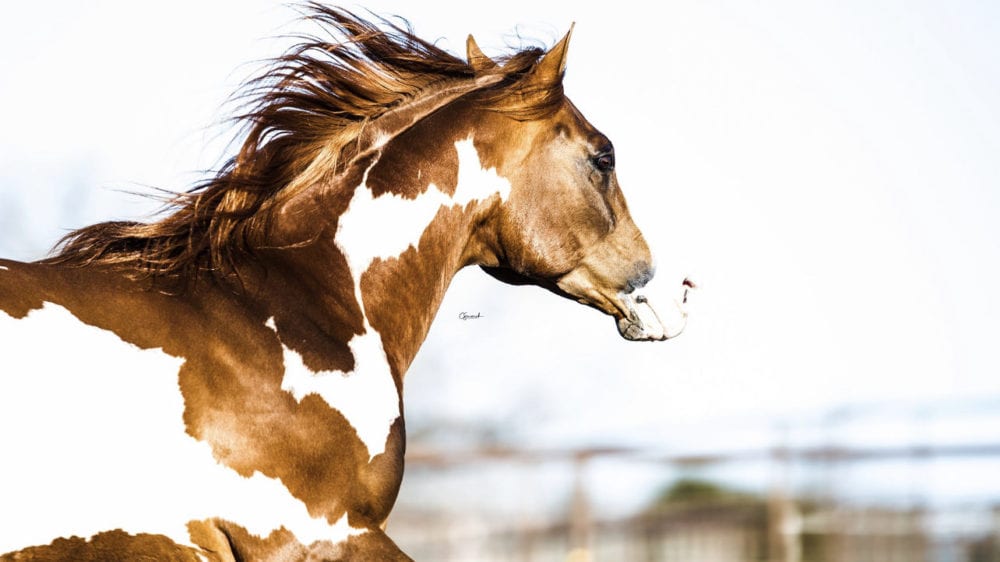Loudly colored horses in the stock breed world can be a complicated topic. There is a history of registration requirements that either exclude or include based on color markings and patterns. And the legacy of thinking that there is a natural prejudice against colorful horses in subjectively judged events does exist.
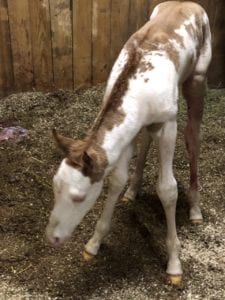 However, there is also the increasingly granular understanding of the complex role genetics plays in the expression of color genes across many breeds. As our sport modernizes in both trends and breeding practices and judging continues to focus on rewarding the best horses, it is easier than ever to look into any show pen and find many horses of a different color.
However, there is also the increasingly granular understanding of the complex role genetics plays in the expression of color genes across many breeds. As our sport modernizes in both trends and breeding practices and judging continues to focus on rewarding the best horses, it is easier than ever to look into any show pen and find many horses of a different color.
GoHorseShow spoke with some leading breeders and owners of loud-colored horses who have registration status with multiple associations about the rising popularity of these unique equines.
About Our Color Enthusiasts
Leigh Ann Griffith is a longtime breeder of world-class horses in wide-ranging disciplines. Along with her husband, Sid, Leigh Ann operates Sid Griffith Equestrian Center in the Columbus, OH area. Griffith has experience within numerous major organizations including AQHA, NRHA, NSBA, and USEF.
Cathy Corrigan Frank, of Phoenix, AZ, is the owner of APHA/AQHA/PtHA stallion Living Large who is by These Irons Are Hot. Living Large is a can’t miss in color and is also a multiple World Champion and Reserve Congress Champion.
Tina Eller, along with her husband David, is a longtime breeder and exhibitor of world-class halter horses. The Ellers have primarily focused on breeding APHA horses, however, have seized opportunities to expand their breeding focus by including horses who are AQHA eligible as well.
Primer on White Markings & Registration
 While APHA and PtHA have their own requirements for white markings and pedigree, it helps to first understand AQHA registration requirements and restrictions. The following crosses are accepted for AQHA registration:
While APHA and PtHA have their own requirements for white markings and pedigree, it helps to first understand AQHA registration requirements and restrictions. The following crosses are accepted for AQHA registration:
Registered Appendix x Registered Quarter Horse
Registered Quarter Horse x Registered Quarter Horse
Registered Thoroughbred x Registered Quarter Horse
Pictured above is Living Large (Shaq) whose mother, Quit Staring is a rare thoroughbred with loud and black coloring, he is by AQHA stallion These Irons Are Hot.
A Primer on the White Genetics
The following is a list of the genetic markers that are dominant genes associated with white coat patterns and expression. For this primer, dominant means that horses only need to have one copy of the gene to display physical white traits, although that expression of white can vary widely.
 The list includes the name of the genetic marker as well as how/where the gene was identified (if known) and the breed and pedigree association the marker is most commonly found in. Another factor (not discussed here) in the physical expression of a color gene involves the location of the genetic marker on a specific gene. Other genes are involved with white markings.
The list includes the name of the genetic marker as well as how/where the gene was identified (if known) and the breed and pedigree association the marker is most commonly found in. Another factor (not discussed here) in the physical expression of a color gene involves the location of the genetic marker on a specific gene. Other genes are involved with white markings.
Dominant White 2 (W2) Thoroughbred: Horses trace back to KY Colonel, a chestnut with extensive white markings, foaled in 1946.
Dominant White 5 (W5) Thoroughbred: Horses trace back to Puchilingui, a stallion foaled in 1984 with a sabino-like coat pattern and his offspring.
Dominant White 6 (W6) Thoroughbred: Identified in a single white horse.
Dominant White 7 (W7) Thoroughbred: Identified in a partially white filly.
Dominant White 10 (W10) Paint/Quarter Horse: Horses trace back to GQ Santana, a stallion foaled in 2000, and his offspring; expression ranges from nearly all-white to horses with face/leg white and belly spots.
Dominant White 12 (W12) Thoroughbred: Identified in a single horse with a sabino-like pattern.
Dominant White 13 (W13) Quarter Horse/Peruvian Paso: Identified in a crossbred family with two white animals.
Dominant White 14 (W14) Thoroughbred: Identified in a completely white horse.
Dominant White 20 (W20) Multiple Breeds: Very common mutation; incomplete dominant trait. Markings might include a wide blaze, leg markings, and small belly spots. Has a subtle effect on depigmentation with a stronger effect on bays than sorrels. Living homozygotes have been found and tend to have more white.
Q: What is your connection to colorful double (DR) registered horses?
Griffith: My daughter [Dakota Diamond Sidwell] got me started with colorful horses. Dakota’s first show horse, My Original Copy, was double registered AQHA/APHA. She is also the dam of The Gentlemens Club [a DR stallion siring foals with lots of white].
 Dakota was probably the reason I started to look into horses with color more; she has such a passion for buckskins and palominos as well as horses with chrome. I stand Signature Of Honor (single papered QH) owned by Dr. April Speyer. He’s always been a favorite of mine, and I love a bay with chrome. When we tested him for color genetics, we found out that he had a copy of the W20 gene and that he also carries the primitive dun gene.
Dakota was probably the reason I started to look into horses with color more; she has such a passion for buckskins and palominos as well as horses with chrome. I stand Signature Of Honor (single papered QH) owned by Dr. April Speyer. He’s always been a favorite of mine, and I love a bay with chrome. When we tested him for color genetics, we found out that he had a copy of the W20 gene and that he also carries the primitive dun gene.
I’m looking to develop future bloodlines, I’m not looking just at color, so this information was exciting. This information paid off this year as we raised a full DR colt. I also have a DR stallion by HBF Ironman. He is a gray overo and carries one copy of the lethal white gene (OLWS) [a known overo gene that produces the tragic “Lethal White Syndrome” if a foal carries two copies]. This colt is a great asset as he’s an extraordinary mover and an athlete with important bloodlines.
Eller: I enjoy breeding and showing APHA horses and of course, who doesn’t love it when the breeding results in a loud colored foal? The push for the DR horse began when my breeding choices many times resulted in a “solid” foal….even when I was breeding a colored mare to a colored stallion.
Corrigan Frank: I own [APHA/AQHA stallion] Living Large and I am currently showing one of his sons in pleasure driving. I plan on showing a filly of his in longe line at the All-American Quarter Horse Congress.
Q: What trends are you seeing when it comes to loud-colored double registered horses in breeding, showing, or marketing?
Griffith: Everybody seems to have one. You’re seeing such splashy white, even on the quarter horses. The minimal whites, sabino gene, are also on-trend. This is evolving faster than we can keep up with it. I’m as fascinated by the genetics of these horses as I am by the trend. The American Paint Horse Association is now looking at genetic markers and genealogy/ancestry to really try to preserve the color genetics and I think that’s really important. It is an evolving industry.
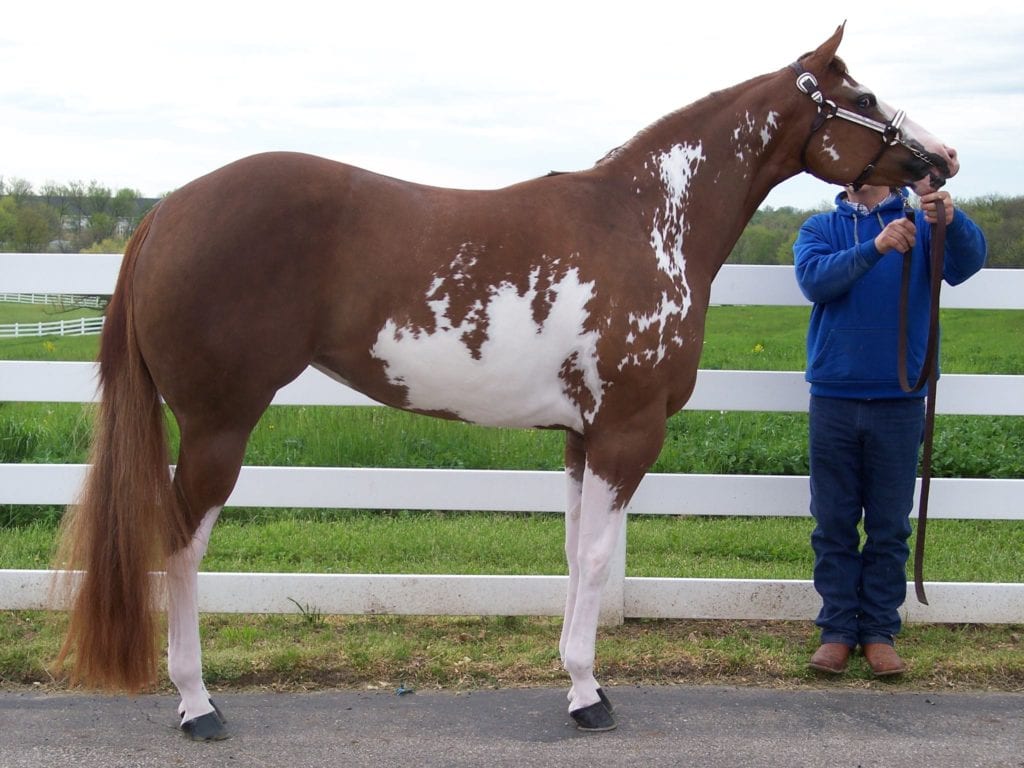 Eller: As far as trends, I feel the market is strong for a double registered horse period. It opens up several avenues for participating in multiple breed associations activities and showing. A colored paint horse is always desirable as it is eye-catching and there aren’t many foals born as frame overo. But, there is another side of the coin…those horses that may have a coat pattern that may distort the horse’s overall appearance. This may be an undesirable thing in the Halter arena for example, where the overall balance may be affected by an animal’s color. Also, a loud DR horse is disqualified from showing in AQHA halter events.
Eller: As far as trends, I feel the market is strong for a double registered horse period. It opens up several avenues for participating in multiple breed associations activities and showing. A colored paint horse is always desirable as it is eye-catching and there aren’t many foals born as frame overo. But, there is another side of the coin…those horses that may have a coat pattern that may distort the horse’s overall appearance. This may be an undesirable thing in the Halter arena for example, where the overall balance may be affected by an animal’s color. Also, a loud DR horse is disqualified from showing in AQHA halter events.
Corrigan Frank: Colored quarter horses are much more common now than ever before. They are more widely accepted in the AQHA show pen, which also makes them more marketable. There have been successful loud reiners for many years and you’re seeing more of them in other disciplines now as well. Now that APHA has changed its rules involving permanent registration for horses with 3 generations of paints, solid horses with that lineage will be worth more as well.
Q: What do you think are the reasons behind this trend? Do you think it will continue?
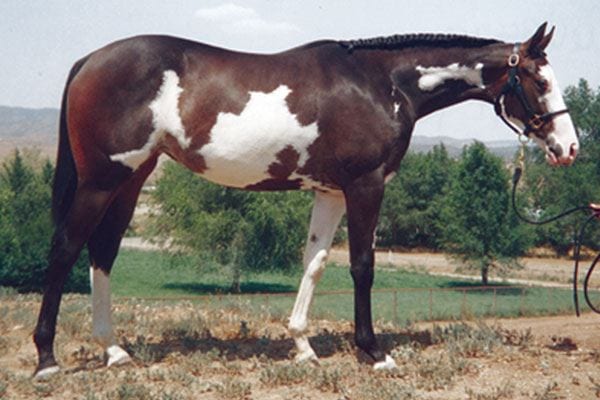 Griffith: We have had an association [AQHA] which has always encouraged Thoroughbred (TB) breeding, and so we have evolved our horses in part from a lot of TB stock. Many of the genetic markers for white are from TB lineage. It is important to note that people today are thinking about how to spend their money and how to maximize their investment when it comes to breeding, buying a horse, and showing. DR means double options. (Pictured left is Living Large’s mother, TB – Quit Staring)
Griffith: We have had an association [AQHA] which has always encouraged Thoroughbred (TB) breeding, and so we have evolved our horses in part from a lot of TB stock. Many of the genetic markers for white are from TB lineage. It is important to note that people today are thinking about how to spend their money and how to maximize their investment when it comes to breeding, buying a horse, and showing. DR means double options. (Pictured left is Living Large’s mother, TB – Quit Staring)
You can go to two sets of shows if you want to, and many events are making it so that you can take any stock breed horse to their futurity show. The colorful, double-registered horse opens up a market and another pathway, which is exciting. Many people just go wild when they see a colorful horse step into the pen.
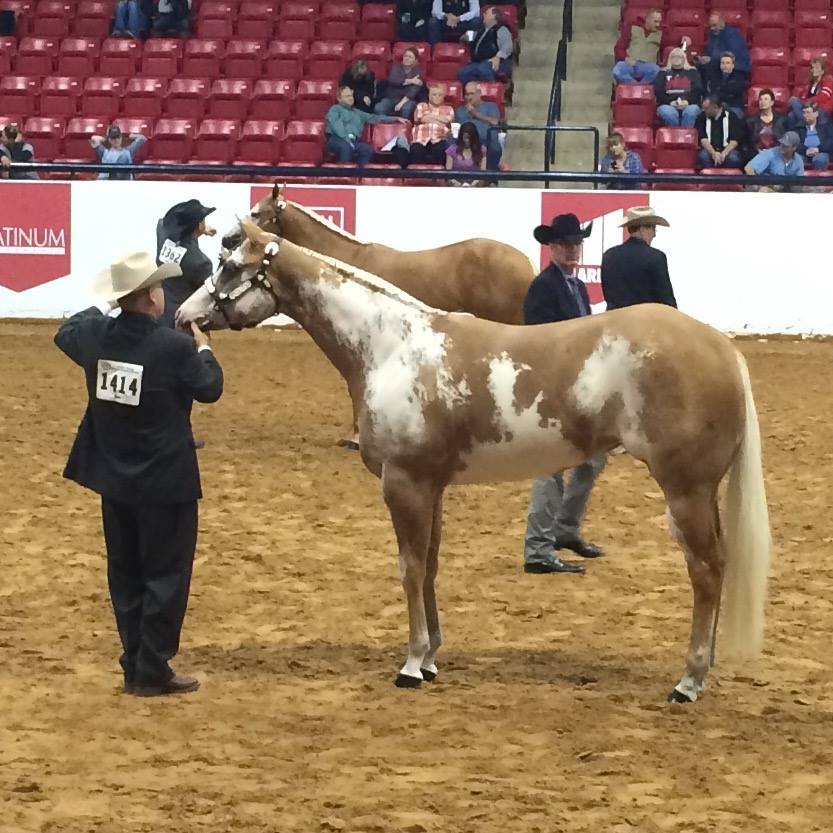 Eller: The choice to breed for a double registered horse was an “insurance plan” for us. There was a registry that a resulting solid foal could participate in, even though we always had our fingers crossed for the possibility of a colored foal. The recent rule change that APHA has adopted may have a significant effect on the loud DR horse. It will now encourage the breeding of two APHA parents, thus bringing back the value of owning a single registered APHA horse. Of course, that won’t diminish the value of the DR horse in my eyes, but I will think again about breeding an AQHA stallion to my APHA mare. I’ll be looking around for the APHA stallion so that I’ll be producing a viable, marketable APHA horse. Kudos to APHA.
Eller: The choice to breed for a double registered horse was an “insurance plan” for us. There was a registry that a resulting solid foal could participate in, even though we always had our fingers crossed for the possibility of a colored foal. The recent rule change that APHA has adopted may have a significant effect on the loud DR horse. It will now encourage the breeding of two APHA parents, thus bringing back the value of owning a single registered APHA horse. Of course, that won’t diminish the value of the DR horse in my eyes, but I will think again about breeding an AQHA stallion to my APHA mare. I’ll be looking around for the APHA stallion so that I’ll be producing a viable, marketable APHA horse. Kudos to APHA.
Corrigan Frank: Choosing a DR, whether it’s loud colored or not, makes the horse more versatile as far as showing goes. More shows are available and if a family has only one horse, but two family members that want to show, one can go to the Paint shows and the other can go to Quarter Horse shows.
Q: Which events seem to embrace the trend of loud-colored DR horses the most? Why might that be?
Griffith: In Reining, there has been acceptance for these horses because the white didn’t matter. They could show at those events, where, for a long time, AQHA did not allow horses with excessive white into the registry. Recognizing horses like Miss White Trash into both registries was a huge step. Today, Hunter and Dressage people go crazy over color, and they embrace it. When you have a good moving horse with color that comes trotting, it is exciting.
Corrigan Frank: Reiners for sure. Thanks to the famous Gunner bloodline, it’s nearly impossible to watch a Reining class without seeing his excessive white trait.
Q: How have registration rules and showing opportunities or restrictions impacted the trend of seeing loud double registered horses?
Griffith: This is where the market is getting really exciting. With the information we have access to, we can focus on being more responsible breeders and developing more customized horses to appeal to different sectors of the market. People like variety in the horse industry, and while you shouldn’t base your prospects just on color requirements, this is a way to both diversify and be very selective.
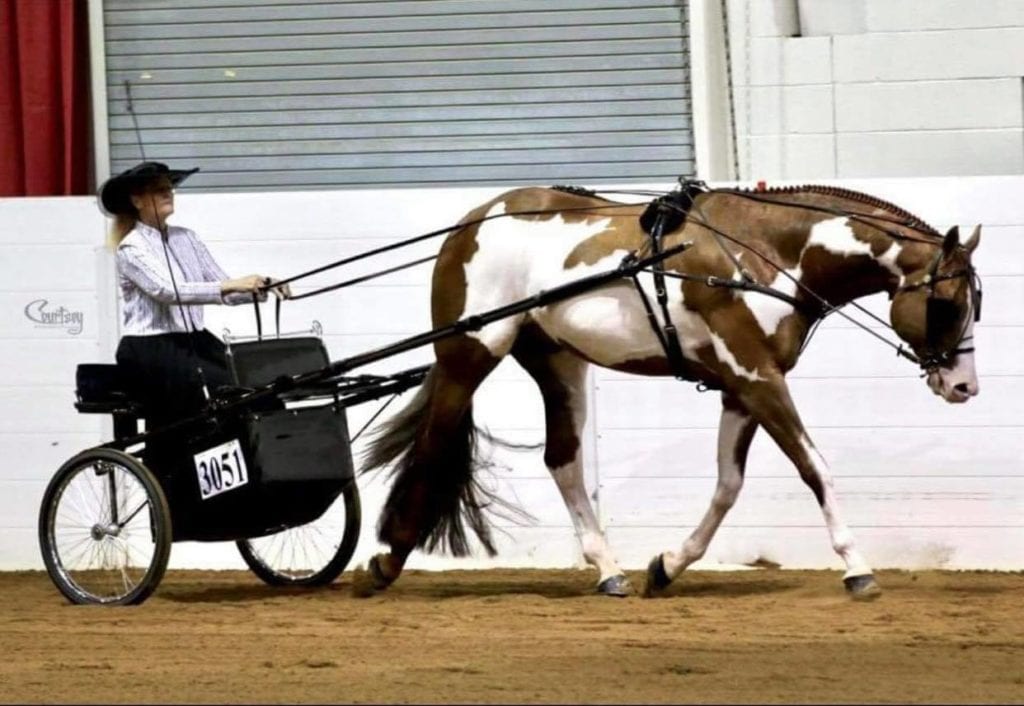 Corrigan Frank: There is still an archaic rule in AQHA that states stallions with excessive white and a Thoroughbred mother cannot have their permanent number even with a ROM…they must be gelded to advance past appendix status. This means they cannot be bred to a TB or appendix mares and produce QH-papered babies by that cross. Being an owner of such a stallion, we have petitioned AQHA to consider changing this rule and have found several other excessive white/TB dam Paint stallions that have been given their number by oversight.
Corrigan Frank: There is still an archaic rule in AQHA that states stallions with excessive white and a Thoroughbred mother cannot have their permanent number even with a ROM…they must be gelded to advance past appendix status. This means they cannot be bred to a TB or appendix mares and produce QH-papered babies by that cross. Being an owner of such a stallion, we have petitioned AQHA to consider changing this rule and have found several other excessive white/TB dam Paint stallions that have been given their number by oversight.
We’d like to thank Leigh Ann, Cathy, and Tina for your insightful interviews into a complicated and often controversial topic. Do you have thoughts on the topic? Let us know in the comments.


